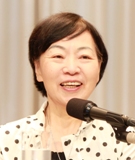Miracles of Our Existence - From Biohistory Perspective
July 28, 2010
Ms. Keiko Nakamura
Director General,
JT Biohistory Research Hall
 ����Biohistory Picture Scroll�� illustrates the diversity of living creatures nurtured over the long history. Numerous creatures are painted on the fan, ranging from bacteria on the right side to microbes, fungi, plants, animals and human beings on the very left.
����Biohistory Picture Scroll�� illustrates the diversity of living creatures nurtured over the long history. Numerous creatures are painted on the fan, ranging from bacteria on the right side to microbes, fungi, plants, animals and human beings on the very left.
��Biohistory Picture Scroll��
Ms. Keiko Nakamura, proponent of Biohistory,
designed the picture to embody the historic context of
each creature and the interrelation among diversified
creatures.
��Original Idea: Keiko Nakamura��
��Consultation: Marina Dan
��Drawing: Ritsuko Hashimoto��������
��Sponsor: JT Biohistory Research Hall
��The pivot of the fan depicts 3.8 billion years ago, when the first form of life is said to have been born on the earth. Ever since, various creatures came into being to form the rich and diversified biological world of today. The picture scroll makes us realize our existence among diversified creatures on this beautiful planet.
��There are 1.7 million recorded species, accounting for only 3% of the whole living organisms. There are still much to study in the tropical rain forest about creatures, especially insects.
��The 10th Conference of the Parties (COP 10) of the Convention on Biological Diversity will be held in Nagoya this October. It is crucial to preserve the habitat of various creatures and to seek ways for sustainable utilization of biological resources. Each one of living organisms is different from the others. Yet, all creatures are composed of cells containing DNAs, which have exactly the same function. We all live by using the same enzymes to generate energy from sugar. We are surely ��diversified��, yet we are universal as we all share the ��same basis,�� should it be bacterium or human being. We all descended from our common ancestor, the cell born in the sea 3.8 billion years ago. We should get two messages from the ��Biohistory Picture Scroll��: firstly ��all creatures live the long history worth 3.8 billion years�� and secondly ��every single organism is equally important.��
����Time�� is an essential element for creatures. Time has generated living organisms, and we live as we consume time. ��Interrelation�� is another essential element, because not a single creature can live without other creatures. Modern society has pursued ��efficiency�� which required us to reduce the time. In modern society evaluation is based on efficiency, thus further promoting mechanization. Yet, living creatures are different from machines, and we cannot live for efficiency. For example, human beings can never skip ages, as each process of our growth is essential. Education for children might seem time-consuming, yet we must view it as an essential stage requiring ��time and interrelation as living creatures.�� A new set of values that draw a line between ��living creatures�� and ��machines�� must underlie the society.
��Children of today have fewer opportunities to play in the natural environment. Let me share with you the activities called ��farming experience classes at elementary schools�� in which I have been engaged. The farming experience classes started 4 years ago at Kitakata City in Fukushima Prefecture. Three elementary schools joined the first year, followed by nine schools on the second year, and this year all elementary schools came to join. I am so surprised to see how much the children in Kitakata acquired their zest for life. Firstly, all the children have wonderful smiles. Secondly, children gained negotiation skills, as they communicate with the elderly in the area to ask for their help in farming. Children have come to respect the grown-ups who teach them how to farm. The grown-ups also became revitalized by children. The third outcome is that children gained skills for self-expression, as they wrote essays or made presentations on farming.
��Children at Toyooka City in Hyogo Prefecture started activities to revive a stork-friendly environment. Children realized that storks needed cultivated fields with fishways from rivers for loaches. The cost to build one fishway was as much as 300,000 yen, which could not be covered by their pocket money. So the children negotiated with the forestry cooperative and succeeded in getting their cooperation to build a nice fishway. Besides, good-quality rice was harvested from the fields for storks, which are today served for school meals, thanks to the children��s skillful negotiations with the mayor. We have learnt from these practical classes that children develop an insight into living creatures. It is our sincere wish that these activities will spread throughout the country.
��Living creatures have existed for 3.8 billion years, and they will continue in the future. Creatures stayed in the sea during the first 3.3 billion years, as water is indispensable for us. Continents were formed 5 billion years ago, pushing the creatures ashore to form today��s diversified ecosystem.
��Analyses on fossils indicate that creatures underwent extinctions as many as 5 times during the 5 billion years. Yet, creatures have the toughness to evolve rapidly from these harsh conditions into diversified species. Although we live in the harsh competitive environment, we are wise enough to seek ways for coexistence, utilizing the capabilities endowed to all living creatures for technological development and economic activities.